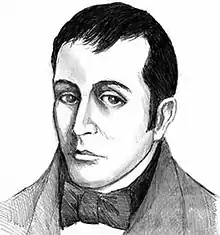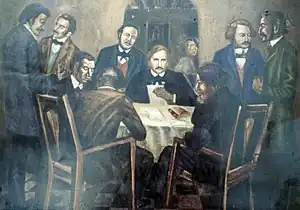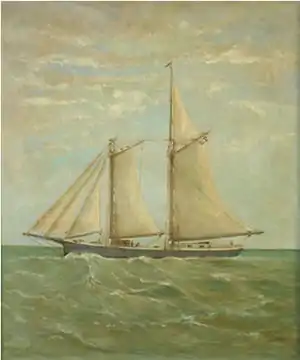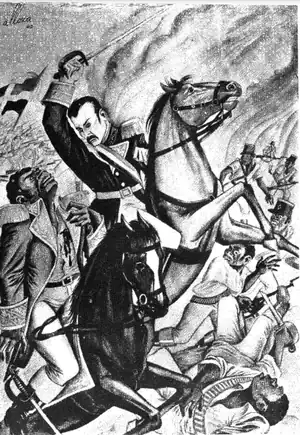Dominican War of Independence
The Dominican War of Independence (Spanish: Guerra de Independencia Dominicana) began when the Dominican Republic declared independence on February 27, 1844 and ended on January 24, 1856. Before the war, the island of Hispaniola had been united for 22 years when the newly independent nation, previously known as the Captaincy General of Santo Domingo, was unified with the Republic of Haiti in 1822. The criollo class within the country overthrew the Spanish crown in 1821 before unifying with Haiti a year later.
| Dominican War of Independence | |||||||||
|---|---|---|---|---|---|---|---|---|---|
 Dominican War of Independence, Dominican cavalry charges at Haitian artillery | |||||||||
| |||||||||
| Belligerents | |||||||||
|
|
| ||||||||
| Commanders and leaders | |||||||||
|
|
| ||||||||
| Strength | |||||||||
| 15,000 | 30,000 | ||||||||
| Casualties and losses | |||||||||
|
The exact number of casualties is unknown; however, Haiti is estimated to have lost twice as many troops as the Dominican Republic.[1] | |||||||||
After the struggles that were made by Dominican patriots to free the country from Haitian control, they had to withstand and fight against a series of incursions that served to consolidate their independence. Haitian soldiers would make incessant attacks to try to gain back control of the nation, but these efforts were to no avail, as the Dominicans would go on to win every battle.
In March 1844, 30,000 Haitian soldiers invaded the Dominican Republic at the behest of their president Charles Rivière-Hérard but were defeated within a month and forced to retreat back into Haiti. The Haitian campaign of 1845 ended with the retreat of the Haitian army across the Massacre River. Three years later, Haiti's president (and later emperor) Faustin Soulouque launched his first invasion of the Dominican Republic, but his army was beaten back by forces under General Pedro Santana. In November 1849, a small naval campaign was undertaken in which Dominican government schooners captured Anse-à-Pitres and one or two other villages on the southern coast of Haiti, which were sacked and burned by the Dominicans.[2] In November 1855, Soulouque marched into the Dominican Republic at the head of another army, but the Haitians were decisively defeated and forced back across the border by January 1856.
Background
In the late 18th century, the island of Hispaniola had been divided into two European colonies: Saint-Domingue in the west, governed by France; and Santo Domingo in the east, governed by Spain, occupying two-thirds of Hispaniola. By the 1790s, large-scale slave rebellions erupted in the western portion of the island, which led to the eventual removal of the French and the independence of Haiti in 1804. Following the independence of Haiti, massive portions of the remaining French population were murdered. The eastern portion of the island was preparing itself for an eventual separation from Spain.
_-_Geographicus_-_SantoDomingo-stockdale-1800.jpg.webp)
At the beginning of the 1800s, the colony of Santo Domingo, which had once been the headquarters of Spanish power in the New World centuries prior, was suffering an economic decline. Spain during this time was embroiled in the Peninsular War in Europe, and other various wars to maintain control of the Americas. With Spain's resources spread among its larger colonies, its Caribbean territories became relatively neglected. This period is referred to as the España Boba era.
The Captaincy General of Santo Domingo had approximately 80,000 inhabitants, with the majority being European descendants and mulattos. For most of its history Santo Domingo had an economy based on mining and cattle ranching. The population in the Spanish colony was significantly lower than the French side of the island, which had a population of nearly one million slaves before the Haitian Revolution.
First independence movement

Santo Domingo was regionally divided with many rival and competing provincial leaders. During this period in time the Spanish crown wielded little to no influence in the colony. Some wealthy cattle ranchers had become rulers, and sought to bring control and order in the southeast of the colony where the "law of machete" ruled the land. On November 9, 1821 the former Captain general in charge of the colony, José Núñez de Cáceres, influenced by all the Revolutions that were going on around him, finally decided to overthrow the Spanish government and declared independence from Spanish rule, this would usher in an Ephemeral Independence.
Unification of Hispaniola (1822–1844)
_Portrait.jpg.webp)
A group of Dominican politicians and military officers in the frontier region had expressed interest in uniting the entire island, while they sought power with military support from Haitian officials against their enemies.
Haiti's president, Jean-Pierre Boyer, a mulatto who was seen as an ally promised his full support to the frontier governors, and thus he ceremoniously entered the country with around 10,000 soldiers in February 1822, after most of the cities and towns proclaimed their allegiance to Boyer between November 1821 and January 1822. On February 9, 1822, Boyer formally entered the capital city, Santo Domingo, where he was received by Núñez who offered to him the keys of the Palace. Boyer rejected the offer, while saying: "I have not come into this city as a conqueror but by the will of its inhabitants". The island was thus united from "Cape Tiburon to Cape Samana in possession of one government."
Eventually, the Haitian government became extremely unpopular throughout the country. The Dominican population grew increasingly impatient with Haiti's poor management and perceived incompetence, and the heavy taxation that was imposed on their side. The country was hit with a severe economic crisis after having been forced to pay a huge indemnity to France. A debt was accrued by Haiti in order to pay for their own independence from the European nation; this would give rise to many anti-Haitian plots.
Resistance

In 1838, Juan Pablo Duarte, an educated nationalist, founded a resistance movement called La Trinitaria ("The Trinity") along with Ramón Matías Mella and Francisco del Rosario Sánchez. It was so named because its original nine members had organized themselves into cells of three. The cells went on to recruit as separate organizations, maintaining strict secrecy, with little or no direct contact among themselves, in order to minimize the possibility of detection by the Haitian authorities. Many recruits quickly came to the group, but it was discovered and forced to change its name to La Filantrópica ("The Philanthropic"). The Trinitarios won the loyalty of two Dominican-manned Haitian regiments.[3]
In 1843, the revolution made a breakthrough: they worked with a liberal Haitian party that overthrew President Jean-Pierre Boyer. However, the Trinitarios'[4] work in the overthrow gained the attention of Boyer's replacement, Charles Rivière-Hérard. Rivière-Hérard imprisoned some Trinitarios and forced Duarte to leave the island. While gone, Duarte searched for support in Colombia and Venezuela, but was unsuccessful. Upon returning to Haiti, Hérard, a mulatto, faced a rebellion by blacks in Port-au-Prince. The two regiments of Dominicans were among those used by Hérard to suppress the uprising.[3]
In December 1843, the rebels told Duarte to return since they had to act quickly because they were afraid the Haitians had learned of their insurrection plans. When Duarte had not returned by February, because of illness, the rebels decided to take action anyway with the leadership of Francisco del Rosario Sánchez, Ramón Matías Mella, and Pedro Santana, a wealthy cattle-rancher from El Seibo who commanded a private army of peons who worked on his estates.
On February 27, 1844, some 100 Dominicans seized the fortress of Puerta del Conde in the city of Santo Domingo, and the following day the Haitian garrison surrendered.[3] As these Haitian troops withdrew to the west side of the island, they pillaged and burned.[3] In retaliation, Dominican gunboats bombarded Haitian ports.[5]
Mella headed the provisional governing junta of the new Dominican Republic. On March 14, Duarte finally returned after recovering from his illness and was greeted in celebration.
The population of the new republic stood at approximately 5,200 whites, 135,000 mulattoes, and 34,000 blacks.[6]
War of Independence
Haitian Commander, Charles Rivière-Hérard, sent three columns totaling 30,000 men to try and stop the Dominican uprising.[7] The Battle of Fuente del Rodeo was the first major armed encounter against Haiti in the war. It was fought on March 13, 1844, in the southwest province of Bahoruco. A force of Dominican troops, a portion of the Army of the South, led by General Fernando Taveras, defeated an outnumbering force of the Haitian Army led by Hérard. The Dominicans fought with stones, knives, machetes, lances, clubs, and rifles.[8][9]
The Battle of Azua was fought on March 19, 1844. A force of some 2,200 Dominican troops led by General Pedro Santana defeated an outnumbering force of 10,000 troops of the Haitian Army led by General Souffrand.[10] The Dominicans, who were poorly equipped and undertrained,[11] killed over 1,000 Haitians while only suffering 2 dead and 3 wounded. After this victory, the Dominicans withdrew their headquarters to the Ocoa River, and the valleys of Baní, where their cavalry and lancers could operate; and in this way, they restrained the march of the Haitians, who could not advance beyond Azua; and having then attempted to open a way through the passes of the Maniel, they were in every re-encounter driven back with loss. Meanwhile, in the northern region, the Battle of Santiago was fought on March 30. Although heavily outnumbered, the Dominican troops, led by General José María Imbert, defeated Haitian Army troops led by General Jean-Louis Pierrot.[10]

At sea, the Dominican schooners Maria Chica (3 guns), commanded by Juan Bautista Maggiolo, and the Separación Dominicana (5 guns), commanded by Juan Bautista Cambiaso, defeated a Haitian brigantine Pandora (4 guns) plus schooners Le signifie and La Mouche off the coast of Azua on April 15,[3] sinking all three enemy ships and killing all the Haitian sailors without losing any of their own ships.
As a result of these successive Haitian defeats, Hérard was ousted on May 3, leading to the temporary suspension of Haitian military operations. Santana's forces captured Santo Domingo on July 12 and proclaimed Santana as the ruler of the Dominican Republic. Consequently, the Trinitarios were ousted from power.
On June 17, 1845, Dominican troops from Las Matas, under the command of General Antonio Duvergé, invaded Haiti, capturing four enemy trenches and killing over 100 Haitian troops at the cost of only 2 killed.[12] The invaders captured two towns on the Plateau du Centre and established a bastion at Cachimán.[7] Haitian President Jean-Louis Pierrot quickly mobilized his army and counterattacked on July 13, resulting in over 200 casualties on the Haitian side, while the Dominican forces were able to repulse the attack without suffering any casualties.[12] On July 22, the Haitian forces launched another attack on the Dominican stronghold at Fort Cachimán. The Haitians were repulsed after a battle that lasted three and a half hours, in which the Dominicans only suffered seven casualties.[12] But the arrival of Haitian reinforcements soon compelled the Dominicans to retreat back across the frontier.
On August 6, Pierrot ordered his army to invade the Dominican Republic. A member of La Trinitaria, José María Serra, claimed that over 3,000 Haitian soldiers and less than 20 Dominican militias had been killed at this point.[13] On September 17, 1845, the Dominicans defeated the Haitian vanguard near the frontier at Estrelleta where the Dominican "square" repulsed, with the use of bayonets, a Haitian cavalry charge.[3] On September 27, 1845, Dominican Gen. Francisco Antonio Salcedo defeated a Haitian army at the battle of "Beler," a frontier fortification.[3] Salcedo was supported by Adm. Juan Bautista Cambiaso's squadron of three schooners, which blockaded the Haitian port of Cap-Haïtien.[10] Among the dead were three Haitian generals. On October 28, other Haitian armies attacked the frontier fort "El Invencible" and were repulsed after five hours of hard fighting.[3] In a significant naval action between the Hispaniolan rivals, a Dominican squadron captured 3 small Haitian warships and 149 seamen off Puerto Plata on December 21.[1] On January 1, 1846, Pierrot announced a new campaign. However, in February 27, when he ordered his troops to march against the Dominicans, the Haitian army mutinied, resulting in his overthrow. The war had become highly unpopular in Haiti, and Pierrot's successor was unable to organize another invasion.
On March 9, 1849, Haiti's President Faustin Soulouque of Haiti led 10,000 troops in an invasion of the Dominican Republic. The Haitians attacked the Dominican garrison at Las Matas. According to historian Robert L. Scheina, "The demoralized defenders offered almost no resistance and abandoned their weapons." [3] The Haitian army continued their campaign against the Dominicans, capturing and burning the town of Azua.[12] Dominican General (and presidential contender) Santana raised 800 soldiers and, with the help of several gunboats, routed the Haitian invaders at the Battle of Las Carreras on April 21–22. The battle opened with a cannon barrage and devolved into hand-to-hand combat.[3]
In November 1849, Dominican President Buenaventura Báez launched a naval offensive against Haiti to forestall the threat of another invasion. A Dominican squadron composed of the brigantine 27 de Febrero and schooner Constitución and commanded by Capt. Charles J. Fagalde, a Frenchman, appeared off the Haitian coast, taking prizes. On November 4, the squadron bombarded the Haitian village of Anse-à-Pitres and disembarked a landing party, seizing booty.[14] The next day, the Dominican ships bombarded Les Cayes, captured a schooner and sank some small craft.[14] Fagalde wanted to sail up the Windward Passage between Haiti and Cuba in search of more prizes. However, the Dominican crews mutinied so Fagalde returned to the port of Santo Domingo.[14] On November 8, Soulouque declared the Dominicans pirates, but possessing no naval force at that time he could do little else.[15] Following a Haitian rejection of a Dominican peace proposal, Báez dispatched a second naval expedition against Haiti. On December 3, the squadron composed of the brigantines 27 de Febrero and General Santana and the schooners Constitución and Las Mercedes and commanded by Juan Alejandro Acosta, bombarded and burned the town of Petit Rivière.[15] The Dominicans also captured Dame-Marie on the west coast of Haiti, which they plundered and set on fire.[16]

In 1851, a truce was mediated by the United Kingdom, France, and the United States.[6] By late 1854, the Hispaniolan nations were at war again. In November, 2 Dominican ships captured a Haitian warship and bombarded two Haitian ports.[1] In November 1855, Soulouque, having proclaimed himself Emperor Faustin I of a Haitian empire which he hoped to expand to include the Dominican Republic, invaded his neighbor again, this time with an army of 30,000 men marching in three columns.[1][6] But again the Dominicans proved to be superior soldiers, defeating Soulouque's army, which vastly outnumbered them.
In the south, 4,500 Dominicans led by José María Cabral defeated 12,000 Haitian troops on December 22, 1855, at the Battle of Santomé. The Haitians lost 695 men, including Gen. Antoine Pierrot.[17] On the same day another force of 400 Dominicans defeated 6,000 Haitian troops at the Battle of Cambronal. The Dominicans achieved a subsequent victory over a Haitian contingent of 6,000 soldiers in Ouanaminthe, resulting in the deaths of over 1,000 Haitians, with numerous others wounded and reported missing during their return to the capital.[18] On January 27, 1856, some 8,000 Dominicans defeated 22,000 Haitians at the Battle of Sabana Larga near Dajabón after eight hours of fighting which came down to hand-to-hand combat. Thousands of dead or dying were abandoned on the battlefield.[19] Upon Soulouque's arrival in Port-au-Prince with the remaining remnants of his army, he faced vehement curses from women who had lost their sons, brothers, and husbands in the war.[18] Nevertheless, he succeeded in securing for Haiti possession of Lascahobas and Hinche.[20]
Dominican forces were able to defeat another Haitian invasion in 1859,[6] but the country was in ruins economically and the constant threat of renewed Haitian invasion led Pedro Santana to annex the Dominican Republic to Spain in 1861. The annexation led to a guerrilla war between Dominican nationalists and Spanish forces beginning in 1863. This war resulted in 10,888 Spanish soldiers killed or wounded and another 30,000 dead from yellow fever.[21] Spain spent over 33 million pesos on the war.[22] This immense monetary cost, combined with the heavy human toll of the war, led Spain to finally withdraw its forces in 1865. The Dominicans who opposed the Spanish occupation suffered 4,000 dead, while the pro-Spanish militia under Santana suffered 10,000 casualties during the course of the conflict.[21] The Dominican Restoration War forced Haiti to realize that the goal of conquering the Dominican Republic was unattainable, and it finally recognized its independence in 1867.
No one has estimated the loss of lives and property incurred during the decades of fighting for independence by the Dominicans against Spain, France, Haiti, and then Spain again.[23] To this day, the bitterness held by the Dominicans toward the Haitians suggests that during the fighting between them the loss of life and destruction of property were severe.[24]
Battles
| Battle | Date | Location | Dominican casualties | Haitian casualties | Result |
|---|---|---|---|---|---|
| Battle of Fuente del Rodeo | March 13, 1844 | Baoruco | 1 wounded | n/a | Dominican victory |
| Battle of Cabeza de Las Marías | March 18, 1844 | Neiba | 3 dead | 1,000 dead or wounded | Pyrrhic Haitian victory |
| Battle of Azua | March 19, 1844 | Azua | 2 dead 3 wounded | 1,000+ dead | Dominican victory |
| Battle of Santiago | March 30, 1844 | Santiago | 1 wounded | 600+ dead | Dominican victory |
| Battle of El Memiso | April 13, 1844 | Azua | n/a | n/a | Dominican victory |
| Battle of Tortuguero | April 15, 1844 | Azua | None | 3 ships sunk | Dominican victory |
| Battle of Fort Cachimán | December 6, 1844 | Haiti | n/a | 300+ | Dominican victory |
| Battle of Estrelleta | September 17, 1845 | Elías Piña | 3 wounded | n/a | Dominican victory |
| Battle of Beler | November 27, 1845 | Monte Cristi | 16 dead 25–30 wounded | 350 dead 10 prisoners | Dominican victory |
| Battle of El Número | April 19, 1849 | Azua | n/a | n/a | Dominican victory |
| Battle of Las Carreras | April 21, 1849 | Ocoa | n/a | 500+ dead | Dominican victory |
| Battle of Santomé | December 22, 1855 | San Juan | n/a | 695 dead | Dominican victory |
| Battle of Cambronal | December 22, 1855 | Neiba | n/a | 350 dead | Dominican victory |
| Battle of Sabana Larga | January 24, 1856 | Dajabón | 236 dead | 1,000+ dead Hundreds of prisoners | Dominican victory |
Notes
- Clodfelter 2017, p. 302.
- Schoenrich 1918.
- Scheina 2003.
- The members of La Trinitaria.
- Matibag 2003, p. 113.
- Marley 2005, p. 99.
- Clodfelter 2017, p. 301.
- Caamaño Grullón, Claudio (2007). Caamaño: Guerra Civil 1965. Tomo I. Mediabyte, pp. 10. ISBN 9789945130461.
- Romero, Santo (2008). Raíces étnico-culturales y divisiones territoriales de nuestra isla. Búho. ISBN 9789945162530.
- Showalter 2013.
- Matibag 2003, p. 108.
- José Gabriel García. "Obras Oompletas Volumen 3".
- Serra 1845.
- Scheina 2003, p. 1074.
- Scheina 2003, p. 1075.
- Léger 1907, p. 202.
- Scheina 2003, p. 1076.
- Smith 2014, p. 81.
- Scheina 2003, p. 1077.
- Matibag 2003, p. 118.
- Clodfelter 2017, p. 306.
- Matibag 2003, p. 124.
- Scheina 2003, p. 1084.
- Scheina 2003, p. 1085.
References
- Clodfelter, Micheal (2017). Warfare and Armed Conflicts: A Statistical Encyclopedia of Casualty and Other Figures, 1492-2015 (4th ed.). McFarland.
- Léger, Jacques Nicolas (1907). Haiti: Her History and Her Detractors. The Neale Publishing Company.
- Marley, David (2005). Historic Cities of the Americas: An Illustrated Encyclopedia. ABC-CLIO.
- Matibag, E. (2003). Haitian-Dominican Counterpoint: Nation, State, and Race on Hispaniola. Springer.
- Scheina, Robert L. (2003). Latin America's Wars. Potomac Books.
- Schoenrich, Otto (1918). Santo Domingo: A Country with a Future. Library of Alexandria.
- Showalter, Dennis (2013). Imperial Wars 1815-1914. London: Amber Books. ISBN 978-1-78274-125-1. OCLC 1152285624.
- Smith, Matthew J. (2014). Liberty, Fraternity, Exile: Haiti and Jamaica after Emancipation. UNC Press Books.
- Serra, José María [in Spanish] (1845). "Los Haitianos". El Dominicano. No. 1.